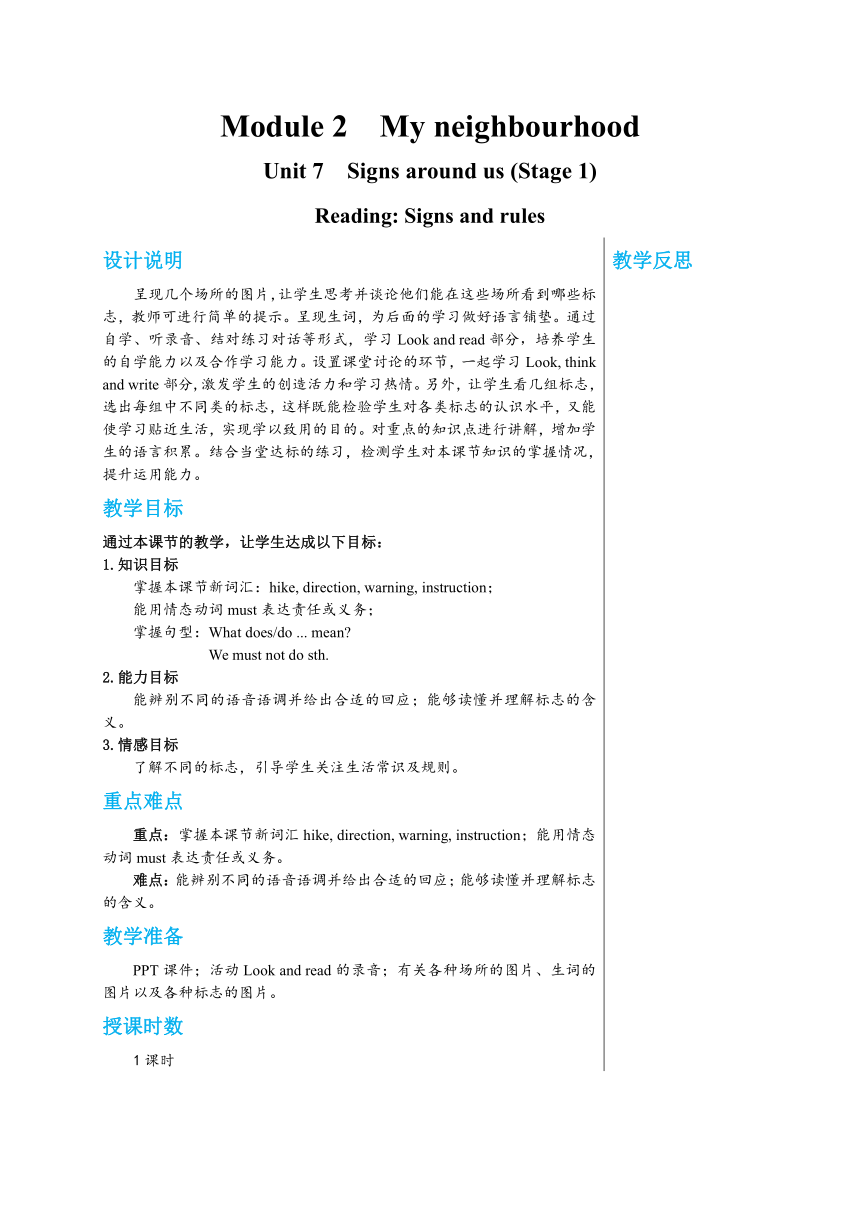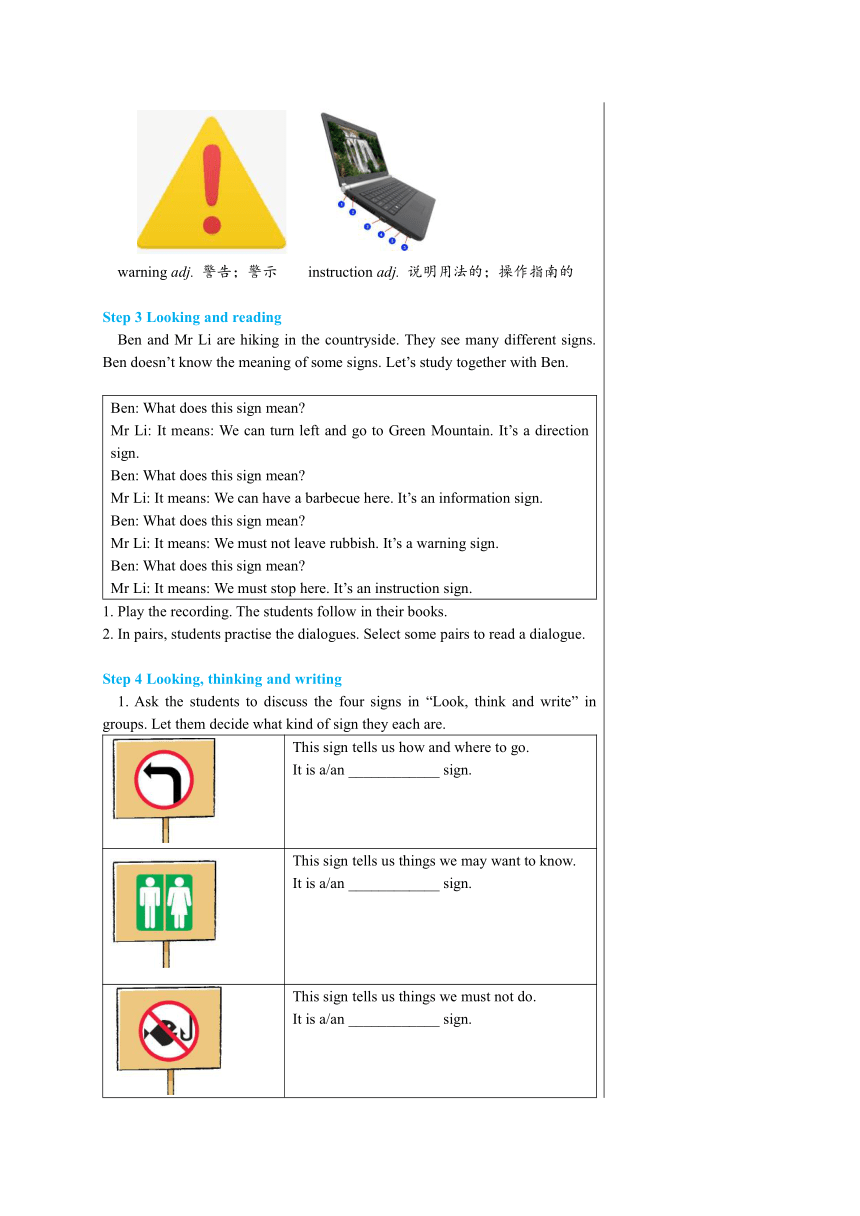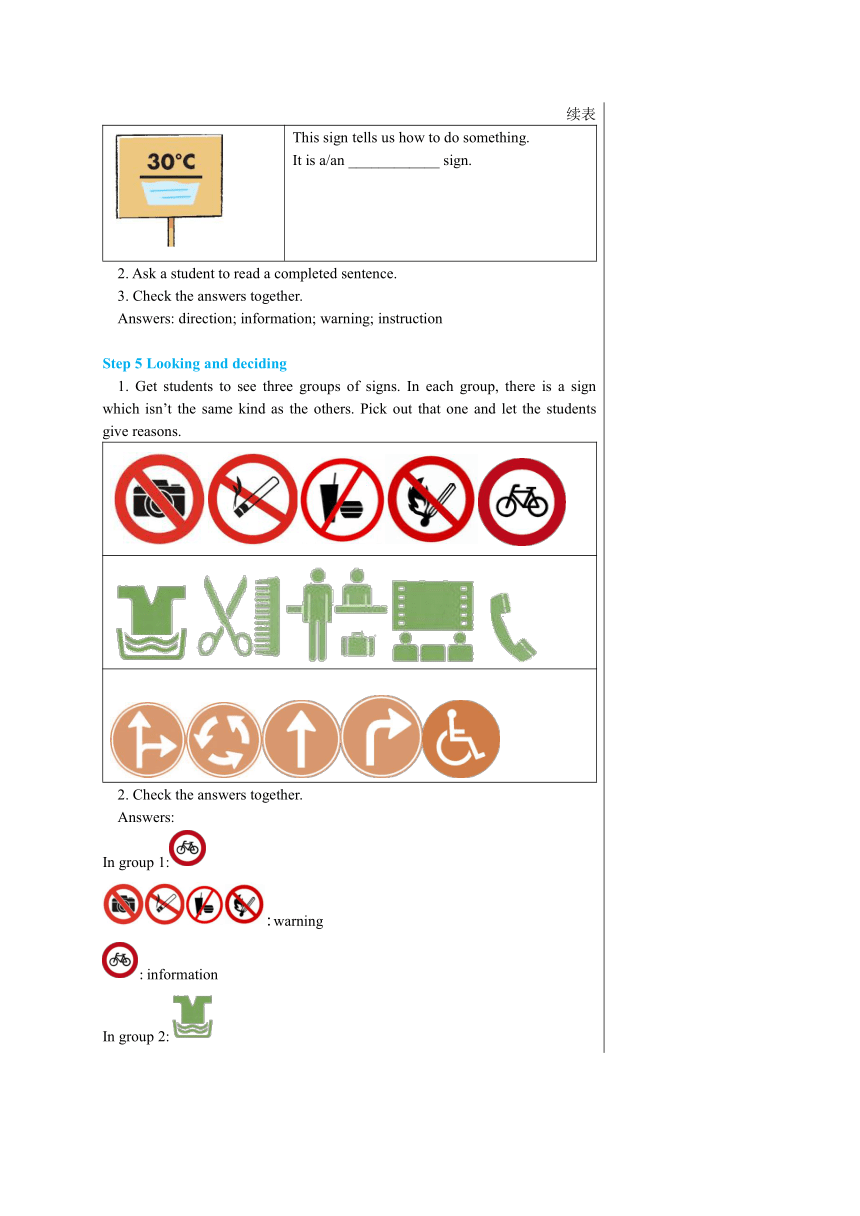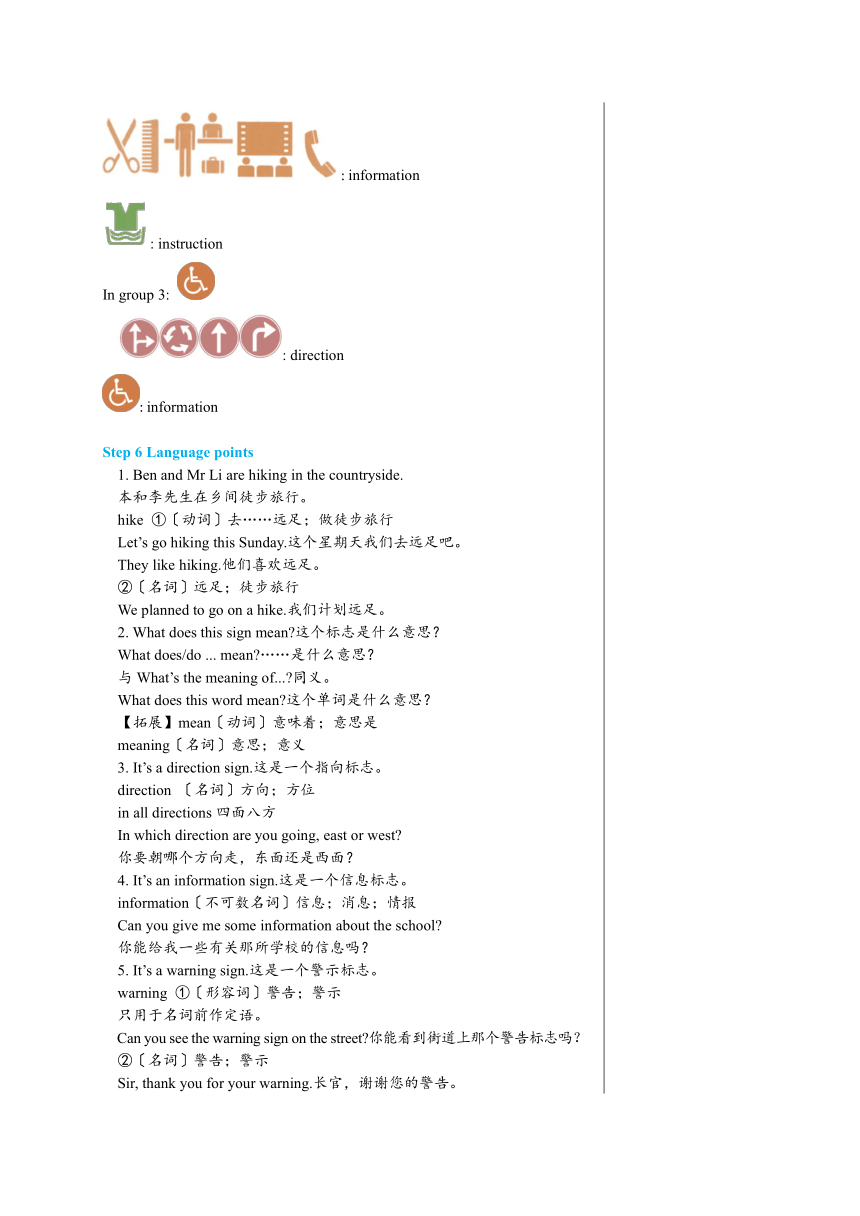Module 2 Unit 7 Signs around us Reading 教案
文档属性
| 名称 | Module 2 Unit 7 Signs around us Reading 教案 |

|
|
| 格式 | docx | ||
| 文件大小 | 1.8MB | ||
| 资源类型 | 教案 | ||
| 版本资源 | 牛津上海版(试用本) | ||
| 科目 | 英语 | ||
| 更新时间 | 2021-09-26 21:14:34 | ||
图片预览





文档简介
Module
2
My
neighbourhood
Unit
7
Signs
around
us
(Stage
1)
Reading:
Signs
and
rules
设计说明
呈现几个场所的图片,让学生思考并谈论他们能在这些场所看到哪些标志,教师可进行简单的提示。呈现生词,为后面的学习做好语言铺垫。通过自学、听录音、结对练习对话等形式,学习Look
and
read部分,培养学生的自学能力以及合作学习能力。设置课堂讨论的环节,一起学习Look,
think
and
write部分,激发学生的创造活力和学习热情。另外,让学生看几组标志,选出每组中不同类的标志,这样既能检验学生对各类标志的认识水平,又能使学习贴近生活,实现学以致用的目的。对重点的知识点进行讲解,增加学生的语言积累。结合当堂达标的练习,检测学生对本课节知识的掌握情况,提升运用能力。
教学目标
通过本课节的教学,让学生达成以下目标:
1.知识目标
掌握本课节新词汇:hike,
direction,
warning,
instruction;
能用情态动词must表达责任或义务;
掌握句型:What
does/do
...
mean?
We
must
not
do
sth.
2.能力目标
能辨别不同的语音语调并给出合适的回应;能够读懂并理解标志的含义。
3.情感目标
了解不同的标志,引导学生关注生活常识及规则。
重点难点
重点:掌握本课节新词汇hike,
direction,
warning,
instruction;能用情态动词must表达责任或义务。
难点:能辨别不同的语音语调并给出合适的回应;能够读懂并理解标志的含义。
教学准备
PPT课件;活动Look
and
read的录音;有关各种场所的图片、生词的图片以及各种标志的图片。
授课时数
1课时
教学过程
Step
1
Warming
up
1.
Show
some
pictures
to
the
students.
school
street
playground
park
shop
2.
Let
the
students
work
in
pairs.
Talk
about
what
signs
they
can
see
in
these
places.
3.
Get
some
pairs
to
talk
in
front
of
the
class.
Step
2
Presentation
Present
some
new
words:
hike,
direction,
warning,
instruction.
hike
v.
去……远足;做徒步旅行
direction
adj.
方向;方位
warning
adj.
警告;警示
instruction
adj.
说明用法的;操作指南的
Step
3
Looking
and
reading
Ben
and
Mr
Li
are
hiking
in
the
countryside.
They
see
many
different
signs.
Ben
doesn’t
know
the
meaning
of
some
signs.
Let’s
study
together
with
Ben.
Ben:
What
does
this
sign
mean?
Mr
Li:
It
means:
We
can
turn
left
and
go
to
Green
Mountain.
It’s
a
direction
sign.
Ben:
What
does
this
sign
mean?
Mr
Li:
It
means:
We
can
have
a
barbecue
here.
It’s
an
information
sign.
Ben:
What
does
this
sign
mean?
Mr
Li:
It
means:
We
must
not
leave
rubbish.
It’s
a
warning
sign.
Ben:
What
does
this
sign
mean?
Mr
Li:
It
means:
We
must
stop
here.
It’s
an
instruction
sign.
1.
Play
the
recording.
The
students
follow
in
their
books.
2.
In
pairs,
students
practise
the
dialogues.
Select
some
pairs
to
read
a
dialogue.
Step
4
Looking,
thinking
and
writing
1.
Ask
the
students
to
discuss
the
four
signs
in
“Look,
think
and
write”
in
groups.
Let
them
decide
what
kind
of
sign
they
each
are.
This
sign
tells
us
how
and
where
to
go.
It
is
a/an
____________
sign.
This
sign
tells
us
things
we
may
want
to
know.
It
is
a/an
____________
sign.
This
sign
tells
us
things
we
must
not
do.
It
is
a/an
____________
sign.
续表
This
sign
tells
us
how
to
do
something.
It
is
a/an
____________
sign.
2.
Ask
a
student
to
read
a
completed
sentence.
3.
Check
the
answers
together.
Answers:
direction;
information;
warning;
instruction
Step
5
Looking
and
deciding
1.
Get
students
to
see
three
groups
of
signs.
In
each
group,
there
is
a
sign
which
isn’t
the
same
kind
as
the
others.
Pick
out
that
one
and
let
the
students
give
reasons.
2.
Check
the
answers
together.
Answers:
In
group
1:
:warning
:
information
In
group
2:
:
information
:
instruction
In
group
3:
:
direction
:
information
Step
6
Language
points
1.
Ben
and
Mr
Li
are
hiking
in
the
countryside.
本和李先生在乡间徒步旅行。
hike
①〔动词〕去……远足;做徒步旅行
Let’s
go
hiking
this
Sunday.这个星期天我们去远足吧。
They
like
hiking.他们喜欢远足。
②〔名词〕远足;徒步旅行
We
planned
to
go
on
a
hike.我们计划远足。
2.
What
does
this
sign
mean?这个标志是什么意思?
What
does/do
...
mean?……是什么意思?
与What’s
the
meaning
of...?同义。
What
does
this
word
mean?这个单词是什么意思?
【拓展】mean〔动词〕意味着;意思是
meaning〔名词〕意思;意义
3.
It’s
a
direction
sign.这是一个指向标志。
direction
〔名词〕方向;方位
in
all
directions四面八方
In
which
direction
are
you
going,
east
or
west?
你要朝哪个方向走,东面还是西面?
4.
It’s
an
information
sign.这是一个信息标志。
information〔不可数名词〕信息;消息;情报
Can
you
give
me
some
information
about
the
school?
你能给我一些有关那所学校的信息吗?
5.
It’s
a
warning
sign.这是一个警示标志。
warning
①〔形容词〕警告;警示
只用于名词前作定语。
Can
you
see
the
warning
sign
on
the
street?你能看到街道上那个警告标志吗?
②〔名词〕警告;警示
Sir,
thank
you
for
your
warning.长官,谢谢您的警告。
【拓展】warn〔动词〕警告;警示
warn
sb.
(not)
to
do
sth.
警告某人(不要)做某事
I
tried
to
warn
him,
but
he
wouldn’t
listen.我试着警告过他,但是他不听。
They
warn
us
not
to
swim
in
the
river.他们警告我们不要在这条河里游泳。
6.
It’s
an
instruction
sign.这是一个说明标志。
instruction
①〔形容词〕说明用法的;操作指南的
Read
the
instruction
sign
on
the
bag.看一下袋子上的说明标志。
②〔名词(复数)〕用法说明;操作指南
Start
the
machine
according
to
the
instructions.按照说明启动机器。
Step
7
Homework
1.
Complete
the
exercises
in
Workbook
7A
on
page
44.
2.
Preview
“Look,
read
and
match”
on
page
49.
当堂达标
Ⅰ.
选择最恰当的答案
1.
We
didn’t
find
much
________
on
the
Internet.
A.
information
B.
report
C.
article
D.
story
2.
The
police
warned
us
________
basketball
on
the
street.
A.
play
B.
not
play
C.
not
to
play
D.
playing
3.
We
must
________
when
we
see
the
sign.
A.
stop
B.
stopping
C.
to
stop
D.
stopped
Ⅱ.
用括号中所给单词的适当形式完成下列句子,每空格限填一词
1.
They
like
going
________
in
spring.
(hike)
2.
This
sentence
________
best
wishes.
(mean)
3.
The
birds
fly
in
all
________.
(direction)
4.
Fix
the
model
plane
according
to
the
________.
(instruction)
答案:
Ⅰ.1-3 ACA
Ⅱ.1.
hiking 2.
means 3.
directions 4.
instructions
板书设计
Unit
7
Signs
around
us
Reading:
Signs
and
ruleshike
direction
warning
instructionWhat
does/do
...
mean?
We
must
not
do
sth.
教学反思
Module
2
My
neighbourhood
Unit
7
Signs
around
us
(Stage
2)
Reading:
Signs
and
rules
设计说明
设置完成对话的活动,让学生回顾标志的意思,并能判断它们属于哪一类标志。讲解重要的语法点“情态动词can,
must”,让学生学会使用情态动词明示义务和禁止。借助图片呈现生词,做好语言铺垫。设置小组活动,让学生讨论标志并能将标志与其意思匹配起来,由此让学生理解标志的意思及其在生活中的重要作用。另外,分组活动,两个人一组进行对话练习,让学生充分理解标志,并提高学生的课堂参与度。接下来通过把标志归类的活动,让学生能够结合标志的特征使之类型化。对本课中的重要知识点进行讲解,打好语言基础。最后,设置适量当堂检测的题目,检测他们对知识点及情态动词的应用情况。
教学目标
通过本课节的教学,让学生达成以下目标:
1.知识目标
掌握本课节新词汇:silence,
useful,
camp,
go
camping;
能用情态动词can,
must明示义务和禁止。
2.能力目标
能够看懂标志并理解标志的意思;能够正确表达义务和禁止。
3.情感目标
培养学生的规则意识,让他们从小形成遵守规则的习惯,养成优秀的品德。
重点难点
重点:掌握本课节新词汇silence,
useful,
camp,
go
camping;
能用情态动词can,
must明示义务和禁止。
难点:能够看懂标志并理解标志的意思;能够正确表达义务和禁止。
教学准备
PPT课件;有关标志的图片;有关辅助讲解生词的图片。
授课时数
1课时
教学过程
Step
1
Revision
1.
Ask
the
students
to
look
at
some
signs
and
complete
the
dialogues.
A:
What
does
this
sign
mean?
B:
It
means:
(1) .
This
is
a/an
(2)
sign.
A:
What
does
this
sign
mean?
B:
It
means:
(3) .
This
is
a/an
(4)
sign.
A:
What
does
this
sign
mean?
B:
It
means:
(5) .
This
is
a/an
(6)
sign.
A:
How
do
I
clean
my
clothes
according
to
the
(7)
sign?
B:
It
means:
(8) .
2.
Let
them
finish
the
task
by
themselves.
3.
Give
them
some
time
to
discuss
in
groups.
4.
Check
the
answers
together.
Possible
answers:
(1)
we
can
turn
right
(2)
direction
(3)
we
can’t
take
photos
(4)
warning
(5)
this
is
an
elevator
(6)
information
(7)
instruction
(8)
we
can
wash
the
clothes
with
hands
and
the
highest
water
temperature
is
40℃
Step
2
Grammar
情态动词can,
must
情态动词本身有一定的词义,但不能独立作谓语。情态动词表示说话人的语气和情态,情态动词没有人称和数的变化。
1.
can
(1)
表示能力,意为“能,会”,否定形式是can’t,意为“不能,不会”。can的过去式是could。
I
can
speak
English.我会说英语。
Lucy
can’t
spell
the
word.露西不会拼这个单词。
(2)
表示请求或许可,意为“可以”。
—Can
I
go
there,
Mum?妈妈,我可以去那里吗?
—Yes,
you
can.是的,你可以去。
(3)
表示推测,意为“可能”,常用于否定句中。
The
book
can’t
be
John’s.这本书不可能是约翰的。
2.
must
(1)表示义务、命令或必要,意为“必须,应该”。
We
must
keep
our
classroom
clean.我们必须保持教室干净。
(2)
以must开头的疑问句,肯定回答中用must;否定回答中常用needn’t或don’t/doesn’t
have
to,意为“不必”。
—Must
we
finish
the
work
tonight?我们必须今天晚上完成工作吗?
—No,
you
needn’t.不,不必。
(3)
否定结构为mustn’t,意为“禁止,不许”,语气强烈。
You
mustn’t
drive
so
fast.你不许开得这么快。
(4)
表示有把握的肯定推测,意为“一定,准是”。
The
book
must
be
Linda’s.
Her
name
is
on
the
cover.
这本书一定是琳达的。她的名字在封面上。
Step
3
Presentation
Present
some
pictures
and
let
them
learn
the
new
words
and
phrase:
silence,
useful,
camp,
go
camping.
keep
quiet→in
silence
silence
n.
寂静;无声
The
dictionary
is
useful
to
our
study.
useful
adj.
有用的;实用的;有帮助的
camp
v.
宿营;露营
go
camping去露营
Step
4
Looking
reading
and
matching
1.
Let
the
students
discuss
the
signs
in
groups.
Then
ask
them
to
match
the
signs
to
the
sentences
on
page
49.
2.
Ask
some
groups
to
present
their
answers.
3.
Check
the
answers
together.
Answers:
①We
can
park
our
car
here.
②We
can
get
useful
information
here.
③We
can
have
a
barbecue
here.
④We
must
not
smoke
here.
⑤We
must
not
ride
bicycles
here.
⑥We
must
not
fly
kites
here.
⑦We
can
use
the
telephone
for
help.
⑧We
can
have
a
picnic
here.
⑨There
is
a
hospital
here.
⑩There
is
a
shelter
here.
?There
are
toilets
here.
?We
must
not
pick
the
flowers
here.
?We
must
not
fish
here.
?There
is
a
restaurant
here.
?We
can
go
out
here.
?We
must
turn
left
here.
?We
must
stop
our
car
here.
?We
can
go
camping
here.
?We
must
wash
these
clothes
in
warm
water.
?We
must
keep
quiet.
4.
Let
them
work
in
pairs.
Ask
and
answer
like
this:
S1:
What
does
sign
number
one
mean?
S2:It
means:...
S1:
What
kind
of
sign
is
it?
S2:
It’s
a
direction/an
instruction/a
warning/an
information
sign.
S1:
Which
sign
means
“We
can
get
useful
information
here”?
S2:
…
Step
5
Thinking
and
writing
1.
Ask
the
students
to
look
at
the
above
signs
again
and
put
the
numbers
in
the
correct
columns.
WarningInstructionInformationDirection
2.
Let
them
work
in
pairs
and
check
the
answers
together.
3.
Check
the
answers
as
a
class.
Answers:
WarningInstructionInformationDirection4
5
6
12
1315
17
19
201
2
3
7
8
9
10
11
14
1816
【小结】
Step
6
Language
points
1.
We
can
get
useful
information
here.我们可以在此处获取有用的信息。
useful
〔形容词〕有用的;实用的
useful的读音以辅音音素开头,不定冠词用a。
This
is
a
useful
desk.这是一张有用的桌子。
【拓展】use
〔动词〕使用
Can
you
use
the
machine?你会用这台机器吗?
2.
We
must
not
smoke
here.我们一定不能在此处吸烟。
smoke
①〔动词〕吸烟
Please
don’t
smoke
here.
请不要在此处吸烟。
②〔名词〕烟;吸烟
He
wants
to
have
a
smoke.他想吸口烟。
3.
We
can
go
camping
here.我们可以在这儿露营。
go
camping去露营
When
can
we
go
camping
together?我们什么时候一起去露营?
4.
We
must
keep
quiet.我们必须保持安静。
keep
quiet保持安静
是“keep+形容词”结构,表示保持某种状态,keep此时作连系动词。
We
should
keep
quiet
in
the
library.在图书馆我们应该保持安静。
Step
7
Homework
1.
Complete
the
exercises
in
Workbook
7A
on
page
45.
2.
Read
the
sentences
on
page
49.
当堂达标
Ⅰ.
选择最恰当的答案
1.
A
dog
is
useful
animal.
A.
a
B.
an
C.
the
D.
/
2.
_______
is
bad
for
your
health.
A.
Smoking
B.
Smoke
C.
To
smoking
D.
Smokes
3.
The
boys
have
decided
to
_______
next
week.
A.
go
camp
B.
go
camping
C.
going
camping
D.
go
to
camping
4.
Don’t
eat
junk
food.
We
must
_______.
A.
keep
health
B.
keep
healthy
C.
not
keep
health
D.
to
keep
healthy
5.
They
must
_______
there
on
time.
A.
go
B.
goes
C.
have
gone
D.
went
Ⅱ.
根据所给要求完成句子
1.
keep
quiet,
we,
in,
the,
must,
museum
(连词成句)
___________________________________________.
2.
the,
must,
they,
not,
in,
smoke,
hospital
(连词成句)
___________________________________________.
3.
We
can
go
camping
here.
(改为否定句)
We
_____
go
camping
here.
答案:
Ⅰ.1-5 AABBA
Ⅱ.
1.
We
must
keep
quiet
in
the
museum
2.
They
must
not
smoke
in
the
hospital
3.
can’t
板书设计
Unit
7
Signs
around
us
Reading:
Signs
and
rulessilence
useful
smoke
camp
go
camping
keep
quiet情态动词can,
must
1.
can
(1)表示能力
(2)表示请求或许可
(3)表示推测
2.
must
(1)表示义务、命令或必要
(2)以must开头的疑问句
肯定回答中用must;
否定回答中常用needn’t或don’t/doesn’t
have
to
(3)
mustn’t禁止
(4)表示有把握的肯定推测
教学反思
2
My
neighbourhood
Unit
7
Signs
around
us
(Stage
1)
Reading:
Signs
and
rules
设计说明
呈现几个场所的图片,让学生思考并谈论他们能在这些场所看到哪些标志,教师可进行简单的提示。呈现生词,为后面的学习做好语言铺垫。通过自学、听录音、结对练习对话等形式,学习Look
and
read部分,培养学生的自学能力以及合作学习能力。设置课堂讨论的环节,一起学习Look,
think
and
write部分,激发学生的创造活力和学习热情。另外,让学生看几组标志,选出每组中不同类的标志,这样既能检验学生对各类标志的认识水平,又能使学习贴近生活,实现学以致用的目的。对重点的知识点进行讲解,增加学生的语言积累。结合当堂达标的练习,检测学生对本课节知识的掌握情况,提升运用能力。
教学目标
通过本课节的教学,让学生达成以下目标:
1.知识目标
掌握本课节新词汇:hike,
direction,
warning,
instruction;
能用情态动词must表达责任或义务;
掌握句型:What
does/do
...
mean?
We
must
not
do
sth.
2.能力目标
能辨别不同的语音语调并给出合适的回应;能够读懂并理解标志的含义。
3.情感目标
了解不同的标志,引导学生关注生活常识及规则。
重点难点
重点:掌握本课节新词汇hike,
direction,
warning,
instruction;能用情态动词must表达责任或义务。
难点:能辨别不同的语音语调并给出合适的回应;能够读懂并理解标志的含义。
教学准备
PPT课件;活动Look
and
read的录音;有关各种场所的图片、生词的图片以及各种标志的图片。
授课时数
1课时
教学过程
Step
1
Warming
up
1.
Show
some
pictures
to
the
students.
school
street
playground
park
shop
2.
Let
the
students
work
in
pairs.
Talk
about
what
signs
they
can
see
in
these
places.
3.
Get
some
pairs
to
talk
in
front
of
the
class.
Step
2
Presentation
Present
some
new
words:
hike,
direction,
warning,
instruction.
hike
v.
去……远足;做徒步旅行
direction
adj.
方向;方位
warning
adj.
警告;警示
instruction
adj.
说明用法的;操作指南的
Step
3
Looking
and
reading
Ben
and
Mr
Li
are
hiking
in
the
countryside.
They
see
many
different
signs.
Ben
doesn’t
know
the
meaning
of
some
signs.
Let’s
study
together
with
Ben.
Ben:
What
does
this
sign
mean?
Mr
Li:
It
means:
We
can
turn
left
and
go
to
Green
Mountain.
It’s
a
direction
sign.
Ben:
What
does
this
sign
mean?
Mr
Li:
It
means:
We
can
have
a
barbecue
here.
It’s
an
information
sign.
Ben:
What
does
this
sign
mean?
Mr
Li:
It
means:
We
must
not
leave
rubbish.
It’s
a
warning
sign.
Ben:
What
does
this
sign
mean?
Mr
Li:
It
means:
We
must
stop
here.
It’s
an
instruction
sign.
1.
Play
the
recording.
The
students
follow
in
their
books.
2.
In
pairs,
students
practise
the
dialogues.
Select
some
pairs
to
read
a
dialogue.
Step
4
Looking,
thinking
and
writing
1.
Ask
the
students
to
discuss
the
four
signs
in
“Look,
think
and
write”
in
groups.
Let
them
decide
what
kind
of
sign
they
each
are.
This
sign
tells
us
how
and
where
to
go.
It
is
a/an
____________
sign.
This
sign
tells
us
things
we
may
want
to
know.
It
is
a/an
____________
sign.
This
sign
tells
us
things
we
must
not
do.
It
is
a/an
____________
sign.
续表
This
sign
tells
us
how
to
do
something.
It
is
a/an
____________
sign.
2.
Ask
a
student
to
read
a
completed
sentence.
3.
Check
the
answers
together.
Answers:
direction;
information;
warning;
instruction
Step
5
Looking
and
deciding
1.
Get
students
to
see
three
groups
of
signs.
In
each
group,
there
is
a
sign
which
isn’t
the
same
kind
as
the
others.
Pick
out
that
one
and
let
the
students
give
reasons.
2.
Check
the
answers
together.
Answers:
In
group
1:
:warning
:
information
In
group
2:
:
information
:
instruction
In
group
3:
:
direction
:
information
Step
6
Language
points
1.
Ben
and
Mr
Li
are
hiking
in
the
countryside.
本和李先生在乡间徒步旅行。
hike
①〔动词〕去……远足;做徒步旅行
Let’s
go
hiking
this
Sunday.这个星期天我们去远足吧。
They
like
hiking.他们喜欢远足。
②〔名词〕远足;徒步旅行
We
planned
to
go
on
a
hike.我们计划远足。
2.
What
does
this
sign
mean?这个标志是什么意思?
What
does/do
...
mean?……是什么意思?
与What’s
the
meaning
of...?同义。
What
does
this
word
mean?这个单词是什么意思?
【拓展】mean〔动词〕意味着;意思是
meaning〔名词〕意思;意义
3.
It’s
a
direction
sign.这是一个指向标志。
direction
〔名词〕方向;方位
in
all
directions四面八方
In
which
direction
are
you
going,
east
or
west?
你要朝哪个方向走,东面还是西面?
4.
It’s
an
information
sign.这是一个信息标志。
information〔不可数名词〕信息;消息;情报
Can
you
give
me
some
information
about
the
school?
你能给我一些有关那所学校的信息吗?
5.
It’s
a
warning
sign.这是一个警示标志。
warning
①〔形容词〕警告;警示
只用于名词前作定语。
Can
you
see
the
warning
sign
on
the
street?你能看到街道上那个警告标志吗?
②〔名词〕警告;警示
Sir,
thank
you
for
your
warning.长官,谢谢您的警告。
【拓展】warn〔动词〕警告;警示
warn
sb.
(not)
to
do
sth.
警告某人(不要)做某事
I
tried
to
warn
him,
but
he
wouldn’t
listen.我试着警告过他,但是他不听。
They
warn
us
not
to
swim
in
the
river.他们警告我们不要在这条河里游泳。
6.
It’s
an
instruction
sign.这是一个说明标志。
instruction
①〔形容词〕说明用法的;操作指南的
Read
the
instruction
sign
on
the
bag.看一下袋子上的说明标志。
②〔名词(复数)〕用法说明;操作指南
Start
the
machine
according
to
the
instructions.按照说明启动机器。
Step
7
Homework
1.
Complete
the
exercises
in
Workbook
7A
on
page
44.
2.
Preview
“Look,
read
and
match”
on
page
49.
当堂达标
Ⅰ.
选择最恰当的答案
1.
We
didn’t
find
much
________
on
the
Internet.
A.
information
B.
report
C.
article
D.
story
2.
The
police
warned
us
________
basketball
on
the
street.
A.
play
B.
not
play
C.
not
to
play
D.
playing
3.
We
must
________
when
we
see
the
sign.
A.
stop
B.
stopping
C.
to
stop
D.
stopped
Ⅱ.
用括号中所给单词的适当形式完成下列句子,每空格限填一词
1.
They
like
going
________
in
spring.
(hike)
2.
This
sentence
________
best
wishes.
(mean)
3.
The
birds
fly
in
all
________.
(direction)
4.
Fix
the
model
plane
according
to
the
________.
(instruction)
答案:
Ⅰ.1-3 ACA
Ⅱ.1.
hiking 2.
means 3.
directions 4.
instructions
板书设计
Unit
7
Signs
around
us
Reading:
Signs
and
ruleshike
direction
warning
instructionWhat
does/do
...
mean?
We
must
not
do
sth.
教学反思
Module
2
My
neighbourhood
Unit
7
Signs
around
us
(Stage
2)
Reading:
Signs
and
rules
设计说明
设置完成对话的活动,让学生回顾标志的意思,并能判断它们属于哪一类标志。讲解重要的语法点“情态动词can,
must”,让学生学会使用情态动词明示义务和禁止。借助图片呈现生词,做好语言铺垫。设置小组活动,让学生讨论标志并能将标志与其意思匹配起来,由此让学生理解标志的意思及其在生活中的重要作用。另外,分组活动,两个人一组进行对话练习,让学生充分理解标志,并提高学生的课堂参与度。接下来通过把标志归类的活动,让学生能够结合标志的特征使之类型化。对本课中的重要知识点进行讲解,打好语言基础。最后,设置适量当堂检测的题目,检测他们对知识点及情态动词的应用情况。
教学目标
通过本课节的教学,让学生达成以下目标:
1.知识目标
掌握本课节新词汇:silence,
useful,
camp,
go
camping;
能用情态动词can,
must明示义务和禁止。
2.能力目标
能够看懂标志并理解标志的意思;能够正确表达义务和禁止。
3.情感目标
培养学生的规则意识,让他们从小形成遵守规则的习惯,养成优秀的品德。
重点难点
重点:掌握本课节新词汇silence,
useful,
camp,
go
camping;
能用情态动词can,
must明示义务和禁止。
难点:能够看懂标志并理解标志的意思;能够正确表达义务和禁止。
教学准备
PPT课件;有关标志的图片;有关辅助讲解生词的图片。
授课时数
1课时
教学过程
Step
1
Revision
1.
Ask
the
students
to
look
at
some
signs
and
complete
the
dialogues.
A:
What
does
this
sign
mean?
B:
It
means:
(1) .
This
is
a/an
(2)
sign.
A:
What
does
this
sign
mean?
B:
It
means:
(3) .
This
is
a/an
(4)
sign.
A:
What
does
this
sign
mean?
B:
It
means:
(5) .
This
is
a/an
(6)
sign.
A:
How
do
I
clean
my
clothes
according
to
the
(7)
sign?
B:
It
means:
(8) .
2.
Let
them
finish
the
task
by
themselves.
3.
Give
them
some
time
to
discuss
in
groups.
4.
Check
the
answers
together.
Possible
answers:
(1)
we
can
turn
right
(2)
direction
(3)
we
can’t
take
photos
(4)
warning
(5)
this
is
an
elevator
(6)
information
(7)
instruction
(8)
we
can
wash
the
clothes
with
hands
and
the
highest
water
temperature
is
40℃
Step
2
Grammar
情态动词can,
must
情态动词本身有一定的词义,但不能独立作谓语。情态动词表示说话人的语气和情态,情态动词没有人称和数的变化。
1.
can
(1)
表示能力,意为“能,会”,否定形式是can’t,意为“不能,不会”。can的过去式是could。
I
can
speak
English.我会说英语。
Lucy
can’t
spell
the
word.露西不会拼这个单词。
(2)
表示请求或许可,意为“可以”。
—Can
I
go
there,
Mum?妈妈,我可以去那里吗?
—Yes,
you
can.是的,你可以去。
(3)
表示推测,意为“可能”,常用于否定句中。
The
book
can’t
be
John’s.这本书不可能是约翰的。
2.
must
(1)表示义务、命令或必要,意为“必须,应该”。
We
must
keep
our
classroom
clean.我们必须保持教室干净。
(2)
以must开头的疑问句,肯定回答中用must;否定回答中常用needn’t或don’t/doesn’t
have
to,意为“不必”。
—Must
we
finish
the
work
tonight?我们必须今天晚上完成工作吗?
—No,
you
needn’t.不,不必。
(3)
否定结构为mustn’t,意为“禁止,不许”,语气强烈。
You
mustn’t
drive
so
fast.你不许开得这么快。
(4)
表示有把握的肯定推测,意为“一定,准是”。
The
book
must
be
Linda’s.
Her
name
is
on
the
cover.
这本书一定是琳达的。她的名字在封面上。
Step
3
Presentation
Present
some
pictures
and
let
them
learn
the
new
words
and
phrase:
silence,
useful,
camp,
go
camping.
keep
quiet→in
silence
silence
n.
寂静;无声
The
dictionary
is
useful
to
our
study.
useful
adj.
有用的;实用的;有帮助的
camp
v.
宿营;露营
go
camping去露营
Step
4
Looking
reading
and
matching
1.
Let
the
students
discuss
the
signs
in
groups.
Then
ask
them
to
match
the
signs
to
the
sentences
on
page
49.
2.
Ask
some
groups
to
present
their
answers.
3.
Check
the
answers
together.
Answers:
①We
can
park
our
car
here.
②We
can
get
useful
information
here.
③We
can
have
a
barbecue
here.
④We
must
not
smoke
here.
⑤We
must
not
ride
bicycles
here.
⑥We
must
not
fly
kites
here.
⑦We
can
use
the
telephone
for
help.
⑧We
can
have
a
picnic
here.
⑨There
is
a
hospital
here.
⑩There
is
a
shelter
here.
?There
are
toilets
here.
?We
must
not
pick
the
flowers
here.
?We
must
not
fish
here.
?There
is
a
restaurant
here.
?We
can
go
out
here.
?We
must
turn
left
here.
?We
must
stop
our
car
here.
?We
can
go
camping
here.
?We
must
wash
these
clothes
in
warm
water.
?We
must
keep
quiet.
4.
Let
them
work
in
pairs.
Ask
and
answer
like
this:
S1:
What
does
sign
number
one
mean?
S2:It
means:...
S1:
What
kind
of
sign
is
it?
S2:
It’s
a
direction/an
instruction/a
warning/an
information
sign.
S1:
Which
sign
means
“We
can
get
useful
information
here”?
S2:
…
Step
5
Thinking
and
writing
1.
Ask
the
students
to
look
at
the
above
signs
again
and
put
the
numbers
in
the
correct
columns.
WarningInstructionInformationDirection
2.
Let
them
work
in
pairs
and
check
the
answers
together.
3.
Check
the
answers
as
a
class.
Answers:
WarningInstructionInformationDirection4
5
6
12
1315
17
19
201
2
3
7
8
9
10
11
14
1816
【小结】
Step
6
Language
points
1.
We
can
get
useful
information
here.我们可以在此处获取有用的信息。
useful
〔形容词〕有用的;实用的
useful的读音以辅音音素开头,不定冠词用a。
This
is
a
useful
desk.这是一张有用的桌子。
【拓展】use
〔动词〕使用
Can
you
use
the
machine?你会用这台机器吗?
2.
We
must
not
smoke
here.我们一定不能在此处吸烟。
smoke
①〔动词〕吸烟
Please
don’t
smoke
here.
请不要在此处吸烟。
②〔名词〕烟;吸烟
He
wants
to
have
a
smoke.他想吸口烟。
3.
We
can
go
camping
here.我们可以在这儿露营。
go
camping去露营
When
can
we
go
camping
together?我们什么时候一起去露营?
4.
We
must
keep
quiet.我们必须保持安静。
keep
quiet保持安静
是“keep+形容词”结构,表示保持某种状态,keep此时作连系动词。
We
should
keep
quiet
in
the
library.在图书馆我们应该保持安静。
Step
7
Homework
1.
Complete
the
exercises
in
Workbook
7A
on
page
45.
2.
Read
the
sentences
on
page
49.
当堂达标
Ⅰ.
选择最恰当的答案
1.
A
dog
is
useful
animal.
A.
a
B.
an
C.
the
D.
/
2.
_______
is
bad
for
your
health.
A.
Smoking
B.
Smoke
C.
To
smoking
D.
Smokes
3.
The
boys
have
decided
to
_______
next
week.
A.
go
camp
B.
go
camping
C.
going
camping
D.
go
to
camping
4.
Don’t
eat
junk
food.
We
must
_______.
A.
keep
health
B.
keep
healthy
C.
not
keep
health
D.
to
keep
healthy
5.
They
must
_______
there
on
time.
A.
go
B.
goes
C.
have
gone
D.
went
Ⅱ.
根据所给要求完成句子
1.
keep
quiet,
we,
in,
the,
must,
museum
(连词成句)
___________________________________________.
2.
the,
must,
they,
not,
in,
smoke,
hospital
(连词成句)
___________________________________________.
3.
We
can
go
camping
here.
(改为否定句)
We
_____
go
camping
here.
答案:
Ⅰ.1-5 AABBA
Ⅱ.
1.
We
must
keep
quiet
in
the
museum
2.
They
must
not
smoke
in
the
hospital
3.
can’t
板书设计
Unit
7
Signs
around
us
Reading:
Signs
and
rulessilence
useful
smoke
camp
go
camping
keep
quiet情态动词can,
must
1.
can
(1)表示能力
(2)表示请求或许可
(3)表示推测
2.
must
(1)表示义务、命令或必要
(2)以must开头的疑问句
肯定回答中用must;
否定回答中常用needn’t或don’t/doesn’t
have
to
(3)
mustn’t禁止
(4)表示有把握的肯定推测
教学反思
同课章节目录
- Module 1 Relationships
- Unit 1 Relationships in beijing
- Unit 2 Our animal friends
- Unit 3 Friends from other countries
- Module 2 My Neighborhood
- Unit 4 Jobs people do
- Unit 5 Choosing a new flat
- Unit 6 Different places
- Unit 7 Signs around us
- Module 3 Diet and health
- Unit 8 Growing healthy,growing
- Unit 9 International Food Festival
- Unit 10 A birthday party
- Unit 11 My food project
